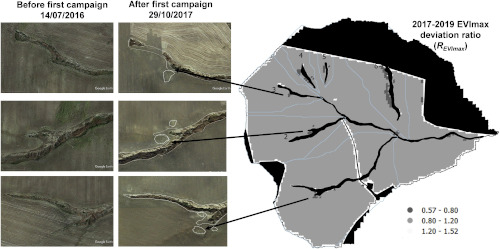The significance of gully filling practices on agricultural production has been only rarely evaluated in literature. In this study, a medium-sized catchment was selected, for being representative of the conventional farming practices on annual crops in the Campiña landscape in Southern Spain. During two wheat campaigns, an analysis of the spatial and temporal evolution of satellite-based vegetation indexes (NDVI, EVI and VH/VV radar polarization ratio) was conducted before and after gully filling practices associated to a rehabilitation project. The development of a linear model of topographic factors along with the calibration of a yield equation using a field survey allowed to determine the expected site-based productivities in the study area. The maximum EVI proved to be the best proxy for wheat yield in a location and was controlled mainly by rainfall and irradiation conditions. A significant yield reduction was found in the vicinity of those gullies affected by soil scraping within the rehabilitation project. Indirect yield losses in the productive land doubled the direct cost of unproductive areas caused by gullying and, when added up to the latter, between 15–25% of the expected yield was found to be lost. Although longer and broader studies are needed to confirm our results, this case study shows that current agricultural practices are not environmentally unsustainable but also economically detrimental. Moreover, it highlights that the impact assessment of gully erosion cannot only be circumscribed to the eroded area but the degradation of gully-adjacent locations must be also considered.

Find all details in the full paper (free access for 48 more days):
Castillo, C., Pérez, R, & Orti, M.V., (2021): The impact of recent gully filling practices on wheat yield at the Campiña landscape in Southern Spain. Soil and Tillage Research. Vol. 212 , pp. 1-13.
Methods of gully detection and monitoring are the core research subject of the PhD project of Miguel Orti in the 3DGeo Research Group on the development of gully identification and measurement methods combining remote sensing and crowdsourcing techniques.
Find more studies focusing on the challenge of identifying, outlining and analysing gully-affected areas in recent publications:
Orti, M.V., Winiwarter, L., Corral-Pazos-de-Provens, E., Williams, J.G., Bubenzer, O. & Höfle, B. (2020): Use of TanDEM-X and Sentinel products to derive gully activity maps in Kunene Region (Namibia) based on automatic iterative Random Forest approach. IEEE Journal of Selected Topics in Applied Earth Observations and Remote Sensing.
Orti, M.V., Negussie, K., Corral-Pazos-de-Provens, E., Höfle, B. & Bubenzer, O. (2019): Comparison of Three Algorithms for the Evaluation of TanDEM-X Data for Gully Detection in Krumhuk Farm (Namibia). Remote Sensing. Vol. 11 (11), pp. 1-22.
This study was supported by Project I+D+i 27451 within the Operative Programme Feder Andalucía 2014–2020 with funds from the Andalusian Government (Consejería de Economía y Conocimiento) and FEDER funds.


